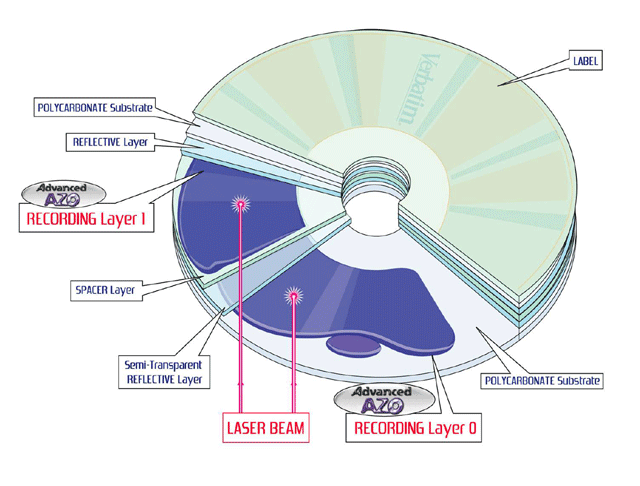DVD-R DL Information
DVD-R DL (Digital Versatile Disc Recordable Dual Layer) is an optical disc of the DVD family that contains two recordable dye layers. The dual layer recordable disc is an extension of the DVD-R format and is also known by the name of DVD-R9. This disc can only be written once, and it holds up to 8.5GB of storage. It stores close to double the data of a single layer disc, but not quite double to avoid cross-recording of layers. Pioneer developed this disc format for the DVD Forum—the industry’s premier association.
The dual layer discs are composed of two organic dye recording layers that are flanked by two polycarbonate bases. They’re topped with metallic reflective layers for data detection by the laser, which are consequently divided by a transparent spacing layer.

The recordable disc’s double layers are comprehended by the drive as a single volume. The first layer’s reflective coating is semi-transparent. Once the laser reads or burns through to the first recordable layer, it can move with ease to the second layer because of the partially transparent layer. A separating layer also exists to prevent unwanted recording of both layers simultaneously.
Each DVD-R DL has a layer with a modulated pre-groove known as a wobble. The wobble is in place to control speed and correctly guide the laser. A dual layer compatible drive will detect the disc and focus on which layer it’s being instructed to read. The laser subsequently zeroes in on the lead-in area (the disc’s indicator of a starting boundary of recording data) which will convey which state the media is in—blank or recorded.
A DVD-R DL’s reader orientation follows an Opposite Track Path (OTP) which starts at the bottom layer’s center as well as near the rim of the top layer while sharing lead-in and lead-out boundaries.
Some players compatible with this format will convey a significant break in audio and video as the laser shifts its optical lens after it reads the first recordable layer through the transparent layer and on to the data’s secondary layer. Amid consumer concerns that this pause was a defect, users will now see a standard message to denote the disc’s nature of the shifting between recorded layers.

